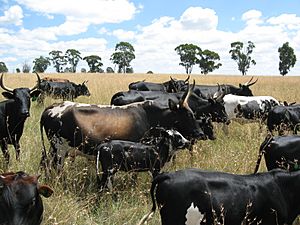Nguni cattle facts for kids
The Nguni is a special type of cattle found in southern Africa. These cattle are known for being very tough and able to live well in different environments. They are a mix of local African cattle and some types of cattle that came from India a long time ago.
Nguni cattle were brought to southern Africa by the Bantu peoples who moved from the north. They are medium-sized animals and enjoy eating grass, especially in areas like the Highveld.
Contents
What Makes Nguni Cattle Unique?
Nguni cattle are quite special because they have many features that help them survive and thrive in southern Africa. They are known for their beautiful, varied coats and strong bodies.
Appearance and Colors
Nguni cattle come in many different colors and patterns. You might see them with solid colors like black, white, brown, or red. But often, they have exciting patterns like spots, stripes, or splashes of different colors. Each Nguni cow can look very different from the next! Their horns also come in many shapes and sizes, which adds to their unique look.
Strong and Healthy Animals
One of the best things about Nguni cattle is how tough they are. They are very good at resisting many diseases that can affect other cattle breeds in Africa. This means they often don't need as much medicine or special care, which is a big help for farmers. They can also handle very hot weather and dry conditions, making them perfect for the African climate.
Adaptability to Different Environments
Nguni cattle are known for being very adaptable. This means they can live comfortably in many different places, from dry grasslands to more bushy areas. They are good at finding food, even when grass is scarce. Their strong legs and hooves help them travel long distances to find the best grazing spots.
History of Nguni Cattle
The story of Nguni cattle is closely linked to the history of people in southern Africa. They have been an important part of life for many communities for hundreds of years.
Arrival with the Bantu Peoples
Nguni cattle arrived in southern Africa with the Bantu-speaking tribes. These tribes migrated from central and eastern Africa many centuries ago, bringing their cattle with them. The cattle helped them survive by providing food, milk, and even hides for clothing and shelter. Over time, these cattle mixed with local types, leading to the Nguni breed we know today.
Importance in Culture
For many African communities, Nguni cattle are more than just farm animals. They are a symbol of wealth and status. They are also used in important cultural ceremonies and traditions. Owning Nguni cattle shows a family's prosperity and connection to their heritage.
How Nguni Cattle Are Used
Nguni cattle are very useful animals and provide many things for people in southern Africa. They are important for both food and cultural reasons.
Meat and Milk Production
Nguni cattle are valued for their meat, which is known for being tasty and lean. They are also used for milk, though they don't produce as much milk as some dairy-specific breeds. However, their milk is rich and nutritious, providing an important food source for families.
Working Animals
In the past, and sometimes even today, Nguni cattle were used as working animals. They helped pull plows in fields or transport goods. Their strength and endurance made them reliable partners for farmers.
Reproduction and Life Cycle
Nguni cattle are known for being very fertile and having a good reproduction rate. Cows usually have their first calf at a young age and continue to have calves regularly. They are also excellent mothers, taking good care of their young. This strong reproductive ability helps keep the Nguni population healthy and growing.


